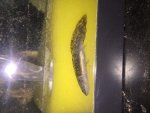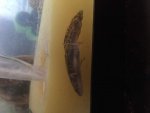mushutheaxie
New member
- Joined
- Nov 28, 2015
- Messages
- 20
- Reaction score
- 0
- Points
- 0
- Country
- United States
Back story: about two weeks ago I got my first axolotl who I named Mushu from a local exotic pet store. He is young (unaware of exactly how young though, and the owner of the pet store had no idea either) and obviously still has a lot of growing to do. I know when they are younger its ok to feed them more often than you would an adult, but how can I tell if I'm feeding Mushu TOO much?
The only reason I ask is because I see him floating at the surface sometimes (not struggling or trying to swim down, just floating there) and I don't want it to be because he is being overfed (I know fish who are overfed have a hard time swimming, I'm unaware if this applies to all aquatic species). Also, his belly seems to be a little fat. He acts healthy, swims a lot, is very active and happily eats any and every time I offer him food. But I just don't want to be overdoing it! I've been feeding him once daily since I've gotten him. The food varies from brine shrimp, blood worms, and beefheart. I would love to give him earthworms but he seems much too small for that still.
Here's some pics I took of his belly the day I noticed him floating.


* Side note, the man I purchased him from recommended I use a sponge filter while he's young, is that ok or should I use something better? He's currently in a 10 gallon tank, I keep his water very cold, doing very small water changes every few days, and he has a glass bottom with a sponge filter.
Sorry for all the questions! I just want to make sure I do everything right! Also there is some discoloration on the outside of his tank but his water is very clean, I don't want the pics to make it appear as if he is in a dirty tank!
The only reason I ask is because I see him floating at the surface sometimes (not struggling or trying to swim down, just floating there) and I don't want it to be because he is being overfed (I know fish who are overfed have a hard time swimming, I'm unaware if this applies to all aquatic species). Also, his belly seems to be a little fat. He acts healthy, swims a lot, is very active and happily eats any and every time I offer him food. But I just don't want to be overdoing it! I've been feeding him once daily since I've gotten him. The food varies from brine shrimp, blood worms, and beefheart. I would love to give him earthworms but he seems much too small for that still.
Here's some pics I took of his belly the day I noticed him floating.


* Side note, the man I purchased him from recommended I use a sponge filter while he's young, is that ok or should I use something better? He's currently in a 10 gallon tank, I keep his water very cold, doing very small water changes every few days, and he has a glass bottom with a sponge filter.
Sorry for all the questions! I just want to make sure I do everything right! Also there is some discoloration on the outside of his tank but his water is very clean, I don't want the pics to make it appear as if he is in a dirty tank!
Last edited:
